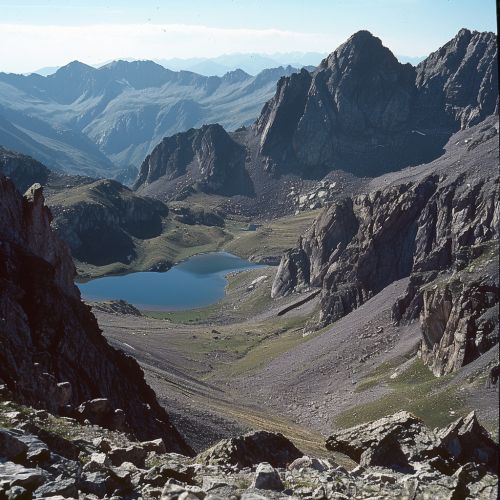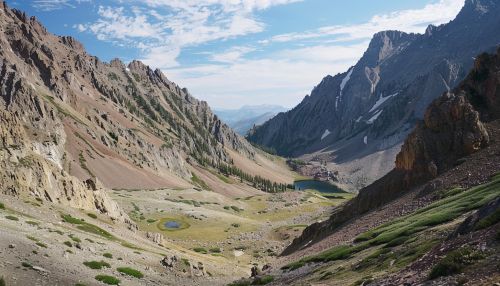Cirque (landform): Difference between revisions
No edit summary |
No edit summary |
||
| Line 23: | Line 23: | ||
The lip of a cirque is the lower edge or rim that separates the cirque from the valley below. It is often formed by the deposition of glacial debris or moraine, which acts as a natural dam, trapping meltwater and forming a tarn. | The lip of a cirque is the lower edge or rim that separates the cirque from the valley below. It is often formed by the deposition of glacial debris or moraine, which acts as a natural dam, trapping meltwater and forming a tarn. | ||
[[Image:Detail-92915.jpg|thumb|center|Mountain cirque with steep headwalls, flat floor, and a small lake.]] | [[Image:Detail-92915.jpg|thumb|center|Mountain cirque with steep headwalls, flat floor, and a small lake.|class=only_on_mobile]] | ||
[[Image:Detail-92916.jpg|thumb|center|Mountain cirque with steep headwalls, flat floor, and a small lake.|class=only_on_desktop]] | |||
== Types of Cirques == | == Types of Cirques == | ||
Latest revision as of 19:55, 21 June 2024
Introduction
A cirque, also known as a corrie or cwm, is a bowl-shaped, amphitheater-like depression found in mountainous regions, formed by the erosive action of glaciers. These landforms are significant in the study of glaciology and geomorphology, as they provide insights into past glacial activity and climatic conditions. Cirques are typically characterized by steep headwalls and a flat or gently sloping floor, often containing a small lake known as a tarn.
Formation and Development
Cirques are primarily formed through the process of glacial erosion. The formation begins with the accumulation of snow in a sheltered hollow on a mountainside. Over time, the snow compacts into ice, forming a small glacier. As the glacier grows, it begins to move under its own weight, eroding the underlying rock through processes such as plucking and abrasion.
Plucking
Plucking occurs when meltwater at the base of the glacier penetrates cracks in the bedrock, refreezes, and subsequently breaks off pieces of rock as the glacier moves. This process is particularly effective in the formation of the steep headwalls characteristic of cirques.
Abrasion
Abrasion involves the grinding action of the glacier as it moves over the bedrock, carrying with it rock fragments that act like sandpaper. This process smooths and deepens the cirque floor, contributing to its bowl-shaped appearance.
Characteristics of Cirques
Cirques exhibit several distinctive features that make them recognizable in the landscape. These include:
Headwall
The headwall is the steep, often vertical, back wall of the cirque. It is formed primarily through the process of plucking and is a key indicator of the erosive power of glaciers.
Floor
The floor of a cirque is typically flat or gently sloping and may contain a tarn, a small lake formed by the melting of the glacier. The floor is shaped by the combined effects of plucking and abrasion.
Lip
The lip of a cirque is the lower edge or rim that separates the cirque from the valley below. It is often formed by the deposition of glacial debris or moraine, which acts as a natural dam, trapping meltwater and forming a tarn.


Types of Cirques
Cirques can be classified based on their size, shape, and location. Some common types include:
Simple Cirques
Simple cirques are the most basic form, characterized by a single, well-defined bowl shape. They are typically found in isolated mountainous regions.
Compound Cirques
Compound cirques consist of multiple interconnected cirques, often forming a complex network of glacially eroded basins. These are commonly found in regions with extensive glacial activity.
Nested Cirques
Nested cirques occur when a smaller cirque forms within a larger one. This can happen when glacial activity intensifies or when a new glacier forms within an existing cirque.
Distribution and Examples
Cirques are found in mountainous regions around the world, particularly in areas that experienced extensive glaciation during the last Ice Age. Some notable examples include:
The Alps
The Alps are home to numerous cirques, many of which are well-preserved due to the region's extensive glacial history. The cirques in the Alps are often used as classic examples in the study of glaciology.
The Rocky Mountains
The Rocky Mountains in North America also contain many cirques, particularly in areas such as Glacier National Park. These cirques provide valuable insights into the region's glacial history and climatic conditions.
The Himalayas
The Himalayas, the highest mountain range in the world, contain some of the most dramatic and well-defined cirques. These landforms are crucial for understanding the glacial dynamics of this region.
Ecological and Climatic Significance
Cirques play a significant role in the local ecology and climate. The sheltered environment of a cirque can create unique microclimates that support specialized plant and animal species. Additionally, the presence of tarns and other water bodies can influence local hydrology and water availability.
Human Interaction and Impact
Cirques have been used by humans for various purposes, including recreation, scientific research, and resource extraction. Hiking, climbing, and skiing are popular activities in cirque regions, while scientists study these landforms to understand past and present glacial processes. However, human activities can also impact cirques, leading to erosion, habitat disturbance, and pollution.
